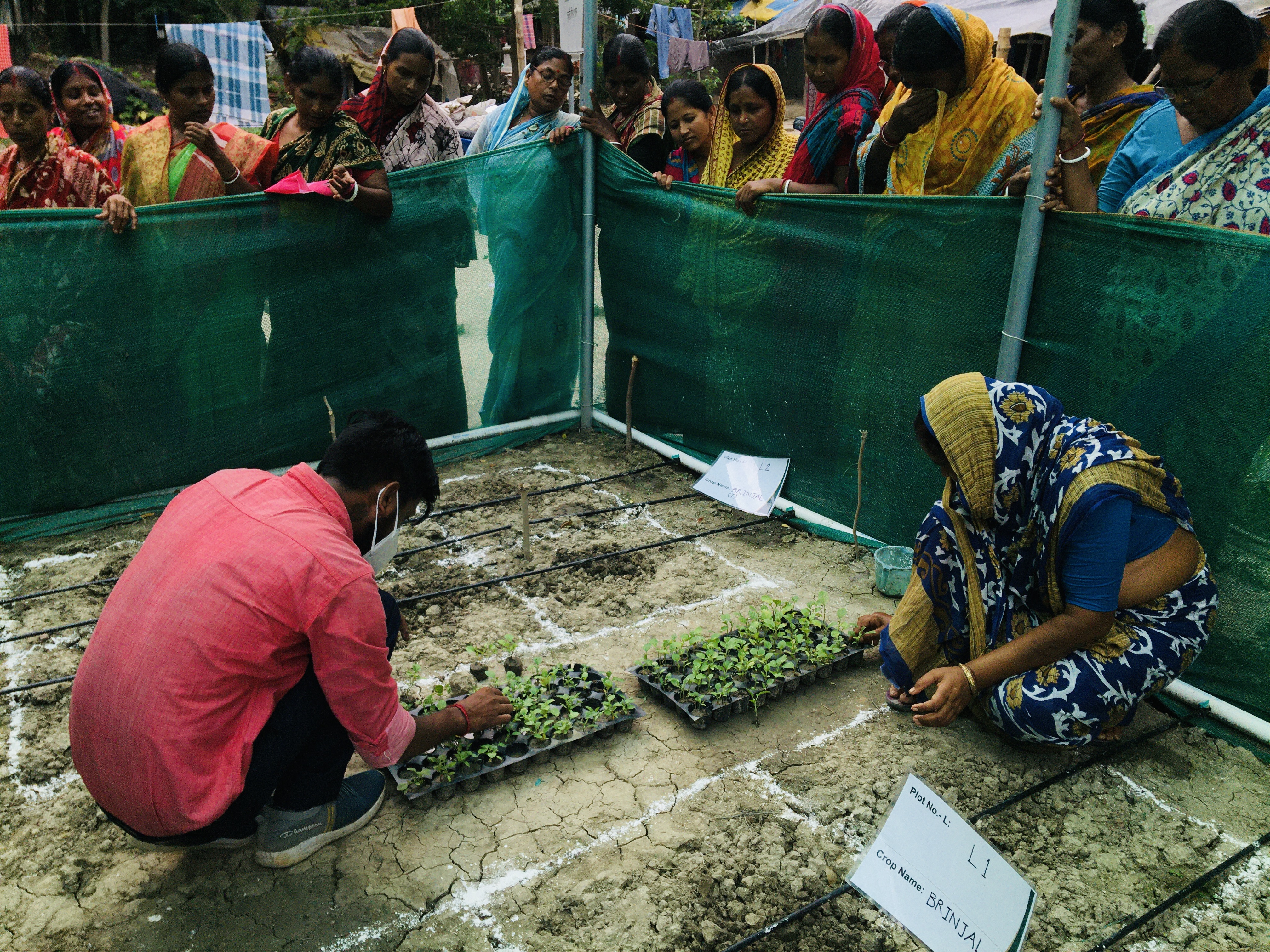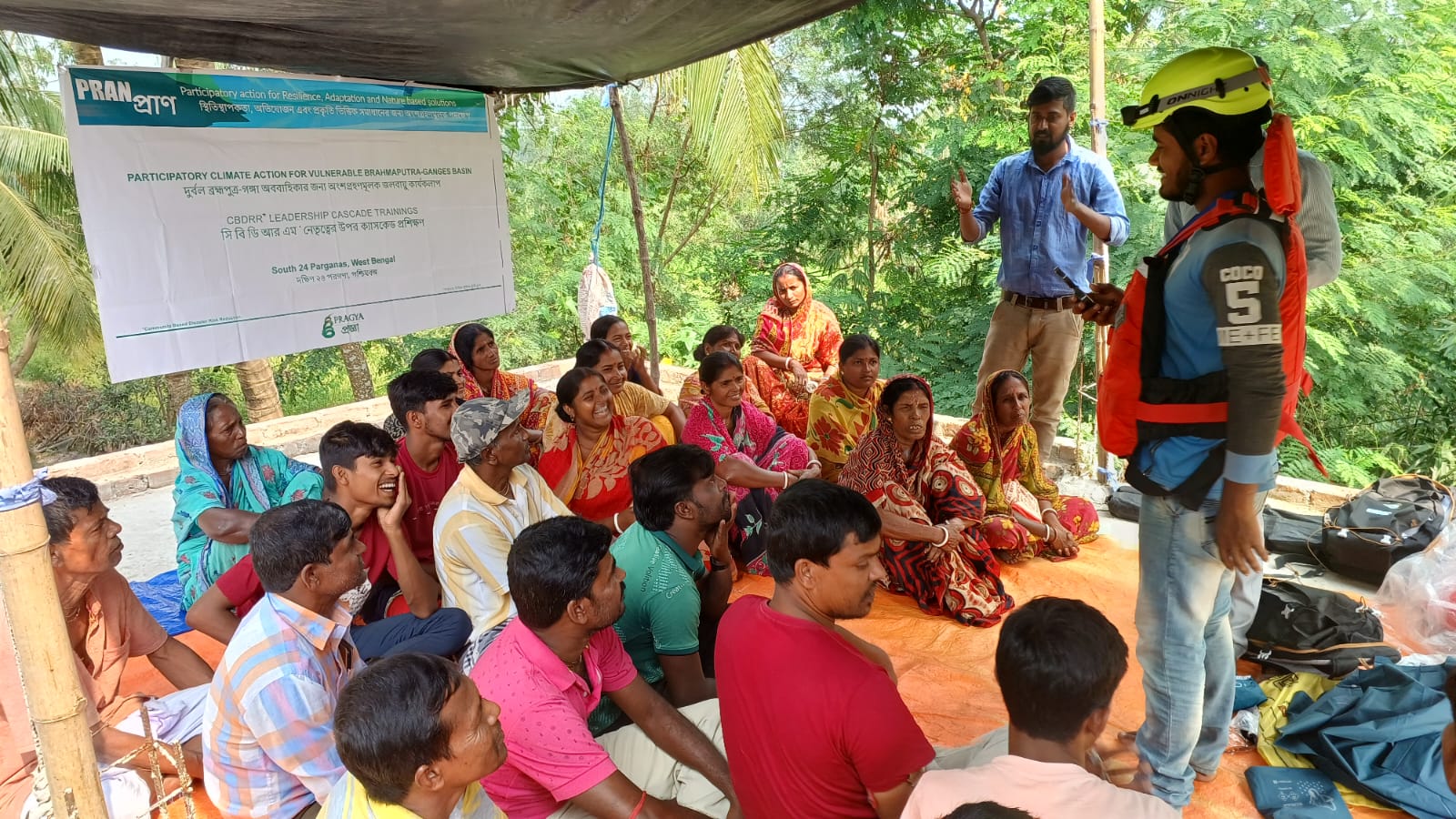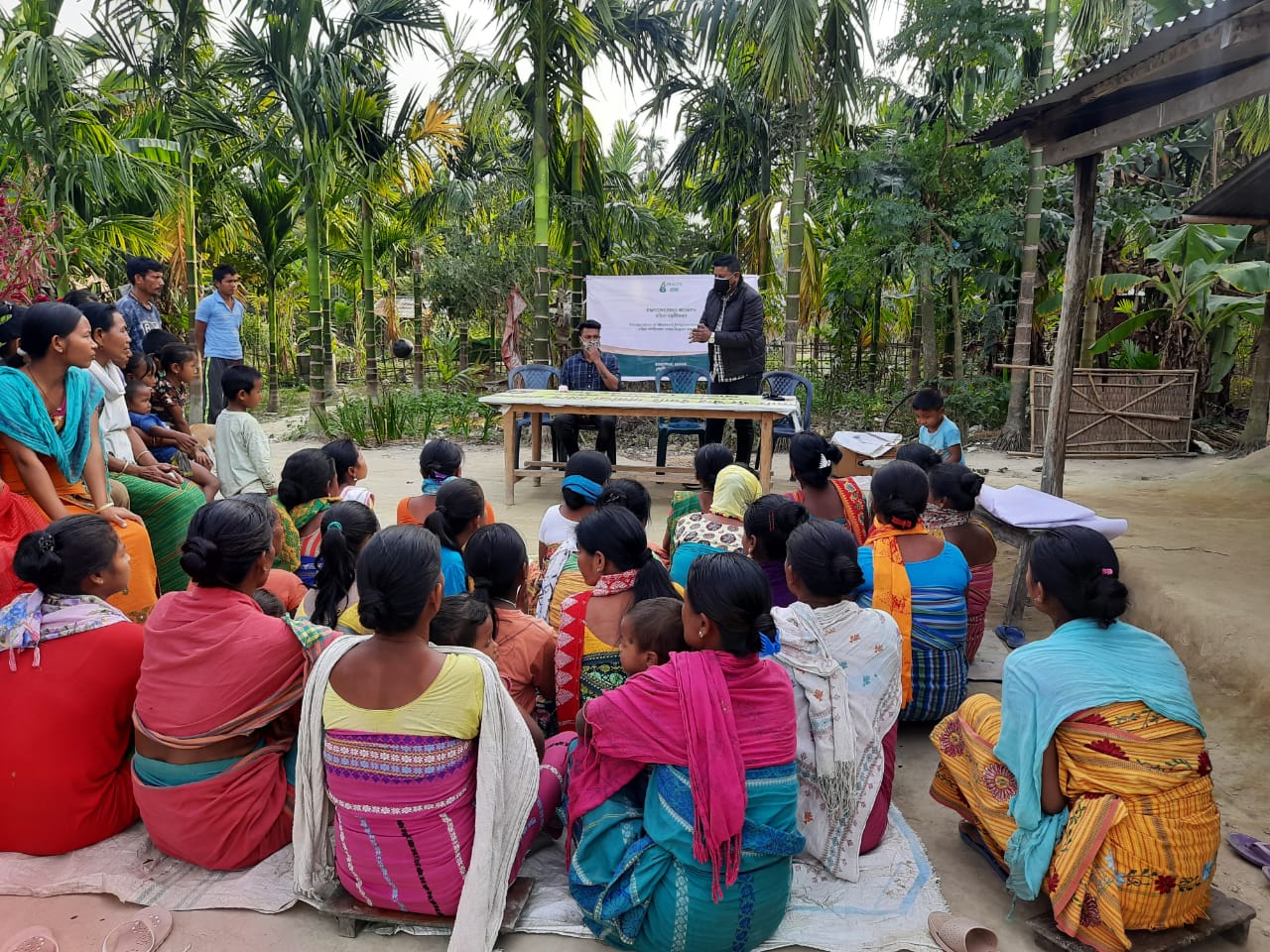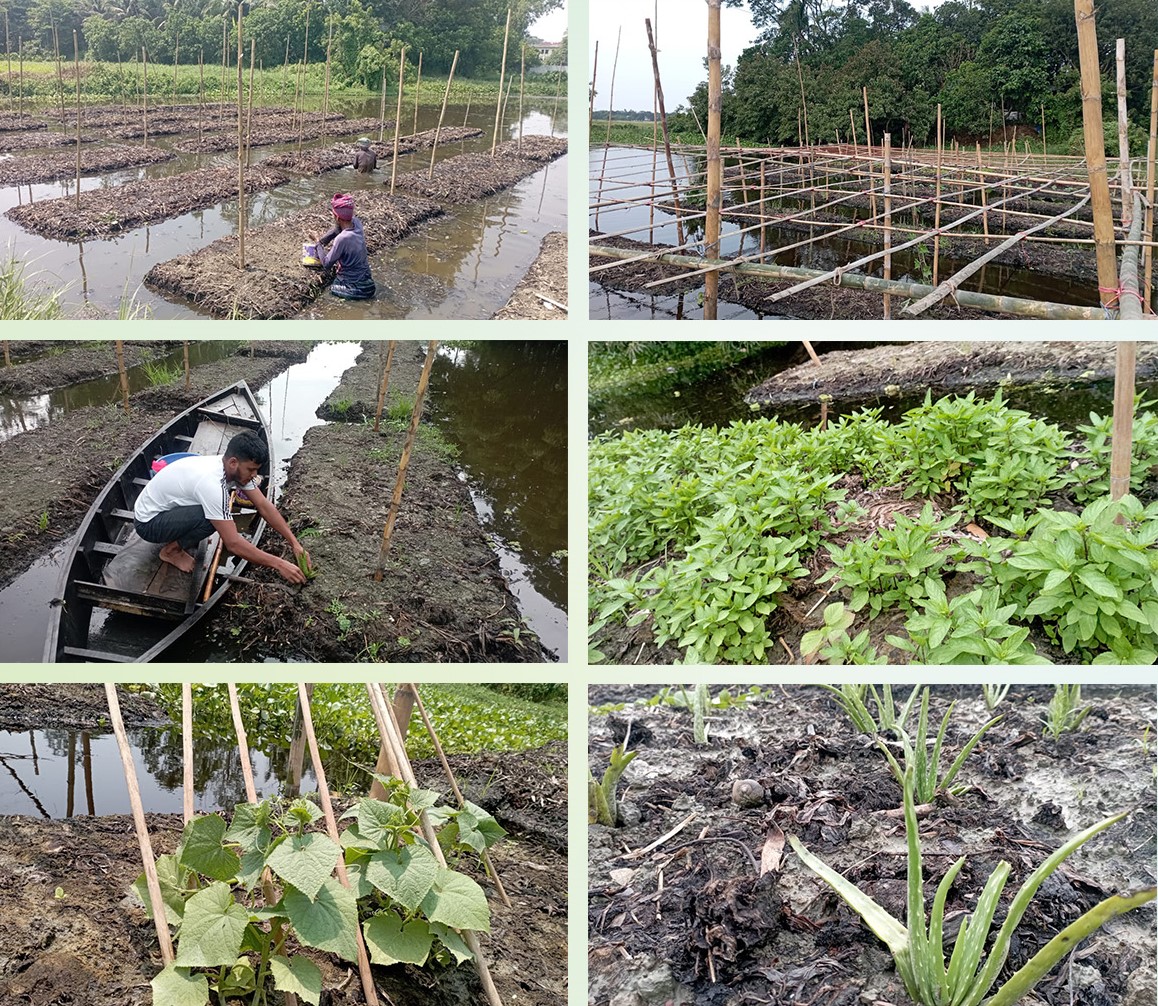Home / What We Do
Climate Action
Climate change is one of the most pressing issues of our time, and South Asia is particularly vulnerable to its impacts. This region, home to over a quarter of the world’s population, is experiencing significant changes in climate patterns, which are exacerbating existing social, economic, and environmental challenges. Additionally, the region is experiencing more intense and unpredictable weather events, including cyclones, floods, and droughts. These extreme events disrupt lives, damage infrastructure, and hinder economic development. Changes in monsoon patterns, prolonged droughts, and flooding are affecting crop yields and threatening the livelihoods of millions of smallholder farmers. The region’s reliance on subsistence farming makes it particularly vulnerable to these climatic shifts, leading to increased food insecurity and poverty. Pragya recognizes that tackling climate change demands a multifaceted approach. We are actively working to enhance resilience through improved agricultural practices, effective water management, and strengthened disaster preparedness. Our community-based interventions have shown significant impact, yet as climate change is a global challenge, it requires regional cooperation and support to amplify these efforts and ensure long-term effects.

Climate Action
Climate Smart & Regenerative Agriculture
The effects of climate change on agriculture in northern Indian plains and the adjoining countries of Nepal and Bangladesh, are profound, leading to declining agricultural productivity. The region is drained by the rivers Ganges, Brahmaputra, Meghna, and referred to as the GBM basin. Erratic weather patterns, including unpredictable rainfall, extended droughts, and more frequent floods, disrupt the growing seasons, resulting in significant crop losses. Coastal areas face additional challenges with salinity intrusion, which degrades the soil, making it unsuitable for rice cultivation, the dominant crop in the region. Farmers' limited access to knowledge of how to mitigate the effects of climate change exacerbates the effects of these changes. As a result, many farmers are increasingly vulnerable to food insecurity, reduced income, and loss of livelihood due to their inability to adapt to changing environmental conditions, which is also spurring out-migration in large numbers. Furthermore, these climate-induced challenges contribute to shrinking employment opportunities in rural areas. The decline in crop yields, driven by unpredictable weather, temperature shifts, increased incidence of pests, and conversion of agricultural land to aquaculture, has reduced economic engagement in agriculture. It not only threaten food security but also leads to a rise in rural poverty and health problems, as livelihoods deteriorate. The compounded effects of both extreme weather events and slower-onset hazards like rising temperatures and salinity make adaptation critical for the long-term sustainability of agriculture and small farmer livelihoods.
Climate Action
Climate Smart & Regenerative Agriculture
Pragya’s proposed solution focuses on promoting Climate Smart Agriculture (CSA) and regenerative agricultural practices through a community-centered approach. Smallholder farmers benefit from a comprehensive Decision Support System (DSS) that enables them to adopt precision farming practices. This system empowers farmers to make data-driven decisions on farm operations, irrigation schedules, and crop choices, ensuring optimal crop yields and minimizing losses caused by climate and soil variations. Through this model, the local farming community are being equipped with the knowledge to manage their farms more effectively, adapting to the shifts in weather patterns in their regions. Technology is playing a crucial role in transforming these agricultural practices. Pragya’s award-winning digital Agri-clinic, is customized to suit the specific needs of the affected regions. This platform provides access to information on climate-resilient crops, alternative farming methods like floating beds, organic farming, conservation agriculture, and precision-farming techniques. A Crop-Advisory contains specific agricultural practices for 144 crops that are grown in the region, including seed treatment measures for improved productivity as well as crop protection practices for adverse weather. Regular Farmer Field Schools organized by local Climate Action Clinics (CACs) at demonstration farms are helping farmers overcome resistance to new technologies and methods, allowing them to see the benefits first-hand. Local youth in the districts are trained on agronomy and sustainable agriculture and facilitated to provide near-at-hand extension services to small farmers. These services include soil testing, weather and crop advisory, and support for adopting new technologies and crops. Female extension workers provide dedicated services to women farmers. By integrating local expertise with advanced agricultural practices and forging linkages with agricultural universities and experts, we ensure that smallholder farmers have access to the latest knowledge and technologies. These collaborative efforts further support farmers in adopting innovative agricultural technologies, exploring potential cash crops and connecting with markets, ultimately fostering resilient and sustainable agriculture in the face of climate change.
Climate Action
Climate Smart & Regenerative Agriculture
GEOGRAPHY / LOCATION

Climate Action
Disaster Risk Reduction
The region is highly susceptible to extreme weather events such as floods, cyclones, landslides and riverbank erosion. The disaster response in the area has been largely reactive and fragmented, lacking adequate preparedness at the local level which means these regions are not equipped to handle disaster risks effectively. Communities, particularly those in remote and distant areas, have to fend for themselves, and government outreach with warnings and relief are often late and inadequate. The increasing frequency and severity of these extreme weather events have a devastating impact on the population. The already chronically poor rural communities are pushed further into impoverishment due to the repeated loss of land, assets, and displacement caused by recurrent natural disasters. Hunger, thirst, diseases, spike during disasters. So does violence against women and children. Moreover, the most marginalised groups frequently reside in the last mile, and/or occupy lowland, riverbank, or coastal areas, and face a perpetual threat of land erosion and flooding, and have very little access to help or relief. These challenges highlight the urgent need for effective disaster risk reduction strategies to mitigate the severe impacts on these vulnerable populations.
Climate Action
Disaster Risk Reduction
Pragya has implemented a comprehensive Disaster Risk Reduction (DRR) strategy combining community-based approaches with technological innovations to enhance resilience in vulnerable regions. A key component is the training of Disaster Risk Reduction (DRR) leaders in the village governance councils, who are equipped to manage and mitigate risks within their communities. The leaders are supported by local youth who are groomed to act as Disaster Response teams to support timely evacuation and necessary relief. Climate Action Centres (CACs), equipped with weather information and multimedia training kits, play a critical role in early warning dissemination and facilitating disaster response. Community-level Hazard Risk Vulnerability Assessments (HRVAs) have identified specific risks, enabling tailored strategies for improving preparedness, with differentiated measures for vulnerable groups. Pragya has also established a Responder Network that links local authorities, weather monitoring agencies, and civil society organizations, facilitating coordinated disaster management efforts. Additionally, the Disaster Risk Reduction Information System (DRRIS), which includes a web platform and mobile app, supports early warning and effective disaster response, especially in remote areas. An Expert Network further strengthens these efforts by providing climate-sensitive and disaster-resistant solutions, ensuring that development initiatives are sustainable and resilient. These integrated solutions collectively empower communities to reduce risks, anticipate and prepare for, and effectively respond to disasters, building long-term resilience.
Climate Action
Disaster Risk Reduction
GEOGRAPHY / LOCATION

Climate Action
Gender Empowerment
Climate change has a global effect, but its impact varies by region and socio-economic capabilities. One common thread is that women face higher risks and burdens from climate change, especially in the Global South. In South Asia, patriarchy-based gender roles and cultural norms exacerbate the challenges women face. In many South Asian countries, women are primarily responsible for tasks such as securing food and water, raising children, and caring for the elderly. These responsibilities are often invisible to the broader social lens, yet they are crucial for community survival. But women also have constrained mobility and low access to training and capacity building, rendering them more vulnerable. Climate change disproportionately affects women, particularly in the Global South, where they bear the brunt of its impacts. Women and girls often spend hours daily collecting water, a task exacerbated by climate-induced droughts and water shortages, which reduces their time for education and income-generating activities. Economic instability is another challenge, as women often work in informal sectors susceptible to climate variability, such as small-scale farming. Additionally, climate-induced disasters can lead to displacement, with women and children facing increased risks of violence and exploitation. In addition, violence against women and girls spikes during disasters, with higher risks of sexual violence, including trafficking and child marriage. Distress and economic pressures following disasters frequently trigger exploitation & abuse of women & girls. Addressing these challenges requires targeted interventions that empower women and integrate their perspectives into climate resilience strategies. By focusing on gender-sensitive approaches, we can ensure that women are not only protected but also play a central role in driving sustainable change.
Climate Action
Gender Empowerment
To mitigate the effects of climate change on women, we have implemented several targeted initiatives. Women’s groups, particularly those focusing on vulnerable populations, receive targeted livelihood support from women-led Women's Information & Assistance Centres (WIACs). This ensures outreach without gender restrictions, enabling women to access necessary resources and support. Dedicated Farmer Field Schools and women-specific farmer conferences are helping to train women in Climate-Smart Agriculture (CSA) and regenerative practices. This empowers women with the knowledge and skills needed to adopt sustainable farming techniques. Additionally, women extension workers for Climate resilience provide special advisory services to women farmers, and assist women farmers in accessing specialized government and financial support, improving adoption of climate-resilient crops, enhancing farm productivity and revenue, ensuring that women farmers can thrive despite climate challenges. We also provide training in alternative income opportunities such as handloom, handicrafts, spice processing, food processing, and hospitality. Women are linked to relevant facilities, utilizing their existing skills and exploring viable business prospects. Women’s Peer Support Groups offer psycho-social support to vulnerable women. Additionally, female leaders are trained to prevent gender-based violence (GBV) and provide protection. Women are also trained in leadership and community vigilance, fostering a supportive community environment. These comprehensive measures are equipping women with the tools and support needed to mitigate the impacts of climate change, enhancing their resilience and improving their quality of life.
Climate Action
Gender Empowerment
GEOGRAPHY / LOCATION
These methods are being implemented across 3 countries- India, Nepal and Bangladesh.

Climate Action
Green Development and Ecosystem based Adaptation (EbA)
The increasing frequency and intensity of extreme weather events, such as floods, cyclones, and droughts, cause significant damage to infrastructure, agriculture, and human settlements. Unsustainable agricultural practices drive soil erosion, loss of fertility, and desertification, thereby reducing agricultural productivity and food security. Climate impacts disproportionately affect vulnerable populations, particularly those dependent on agriculture and natural resources, leading to economic instability and poverty. Additionally, changes in climate and habitat destruction result in the loss of species and ecosystems. Apart from diminishing biodiversity and the resilience of natural systems, the natural protections from these against disasters is reduced, increasing the disaster exposure and intensity that communities on the frontlines have to face. Many regions lack the necessary infrastructure to mitigate and adapt to climate impacts, such as flood defences, resilient housing, and efficient water management systems. Climate change also exacerbates existing social inequities, disproportionately affecting marginalized groups, including women, children, and indigenous communities, who have fewer resources to adapt and recover. Addressing these challenges requires integrated and sustainable approaches that consider both environmental and socio-economic factors.
Climate Action
Green Development and Ecosystem based Adaptation (EbA)
Integrating Green Development principles and Ecosystem-based Approaches (EbA) strategies have resulted in more resilient, sustainable, and equitable outcomes for both people and nature. Green Development promotes sustainable growth while protecting the environment and incorporating ecological considerations into urban planning, infrastructure projects, and community development. By prioritizing Nature-Based Solutions (NbS) like restoring mangroves, wetlands, and other natural barriers, and creating composite systems such as floating farm beds on wetlands, disaster risk reduction has been advanced and biodiversity strengthened. Ecosystem-based Approaches (EbA) have reduced the vulnerability of communities to climate change while simultaneously providing ecological benefits. By working with nature, Ecosystem-Based Approaches and Green Development offer cost-effective, sustainable, and long-lasting solutions that not only protect against climate risks but also provide multiple co-benefits, reduce maintenance expenses, and foster local livelihoods. We are training stakeholders in areas at the frontlines of climate change in these approaches and have set up a range of Nature based Solutions, such as permeable flood barriers, artificial mangrove shelters, floating farm beds, bioswales, etc. that demonstrate these techniques and propel replication. We are also bringing together district governments, local communities, and key actors to collaboratively chart out green development plans that reconcile conservation and infrastructure needs. Empowering local communities with knowledge and resources to implement sustainable practices can significantly mitigate the adverse effects of climate change.
Climate Action
Green Development and Ecosystem based Adaptation (EbA)
GEOGRAPHY / LOCATION

Climate Action
Participatory Climate Action
The Ganges-Brahmaputra-Meghna (GBM) Basin spanning north India, Bangladesh and Nepal, faces severe climate-induced challenges such as floods, cyclones, salinity intrusion, and biodiversity loss. Local communities, particularly small farmers, are vulnerable to frequent disasters, loss of livelihoods, and displacement, but lack adequate capacity to cope effectively. Climate Risk Management is largely a State-driven programme, but lack of coordination between government agencies, civil society, and research institutions, leads to inadequate focus on adaptation and mitigation and a fragmented and reactive disaster response effort.
Climate Action
Participatory Climate Action
Pragya has established a Climate Action Network to connect local authorities, civil society organizations (CSOs), and research institutions, promoting collaborative climate resilience efforts. A key strategy involves mobilizing Community Action & Conservation Groups (CACGs), which include village councils, women’s groups, and youth leaders. These groups will participate in awareness programs focused on climate change, resource scarcity, and disaster hazards, ensuring that future generations and marginalized voices are equipped to drive sustainable change. Climate Action Clinics (CACs) serve as knowledge hubs, offering training, expert consultation, and on-ground support for implementing climate-adaptive solutions. These clinics engage local communities in green infrastructure projects and restorative practices, ensuring active involvement in conservation efforts. Continuous grassroots dialogue and capacity-building initiatives are prioritized to foster climate-resilient development. This approach equips local leaders and communities with the skills needed to implement and sustain climate-resilient strategies. Pragya aims to form a coalition promoting climate-neutral and resilient development throughout the GBM (Ganges-Brahmaputra-Meghna) region, advocating for effective policies and practices. The project also facilitates multi-stakeholder workshops involving community leaders, government officials, and institutions to develop shared action plans and promote nature-based solutions (NBS) for eco-friendly development. This comprehensive approach would put in place a participatory climate action model for effective, community-driven climate adaptation, and ensure ongoing community engagement, with local actors playing a central role in building and sustaining resilience.
Climate Action
Participatory Climate Action
GEOGRAPHY / LOCATION
Pragya’s climate action interventions are being conducted in India ,India, Nepal and Bangladesh.
